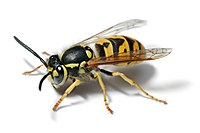
Photo from wikipedia
In the present study we analysed spatial learning in Vespula germanica wasps when dealing with a walking Y-maze. We recorded the time taken to leave the maze during two consecutive… Click to show full abstract
In the present study we analysed spatial learning in Vespula germanica wasps when dealing with a walking Y-maze. We recorded the time taken to leave the maze during two consecutive visits and which of the two short arms was chosen to exit. Two treatments were conducted to evaluate whether wasps learned to leave the Y-maze guided either by spatial or visual cues. In Treatment 1, the colour of both arms remained unchanged between two consecutive visits; and in Treatment 2, the position of the coloured arm was switched after the first trial. Our results demonstrated that the time taken to exit the maze on the second trial was less than half in both treatments and wasps left the maze from the previously chosen arm, irrespective of its colour. This is the first study to demonstrate spatial learning in V. germanica wasps by using a walking Y-maze. Free flying wasps learned to enter the Y-maze on their own volition, walk through it, collect food and find their way out more rapidly after a single foraging experience. The current experimental device is suitable for the evaluation of spatial memory processes and exploratory behaviour in this species.
Journal Title: Behavioural Processes
Year Published: 2021
Link to full text (if available)
Share on Social Media: Sign Up to like & get
recommendations!